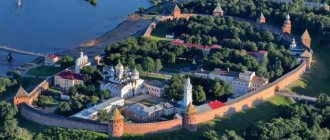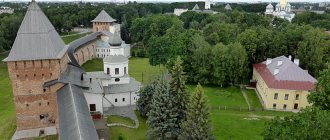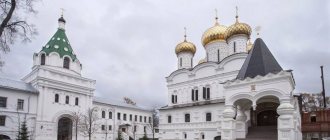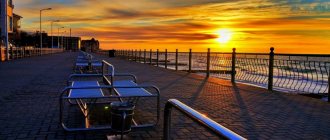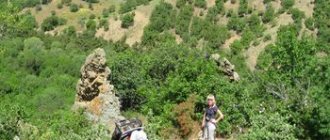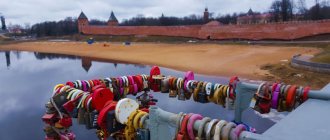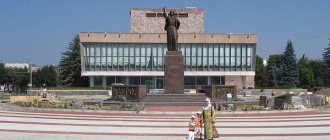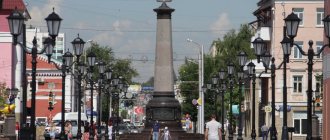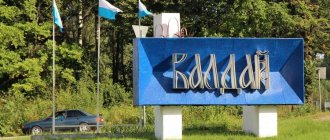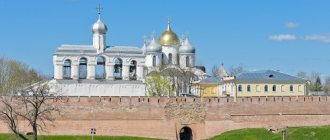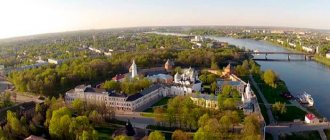Novgorod child
It was first mentioned in chronicles in 1044. The ancient mighty fortress is an architectural monument under the protection of UNESCO. The area of the modern Kremlin is 12 hectares, the length of the walls is 1.5 km, the height of the towers is 41 meters. Climbing the fortress walls and visiting the 9 towers is only possible in good weather. Interesting objects to see are the ancient cathedral and churches, the Clock Bell, the Chamber of Facets, and the sculpture “Millennium of Russia”.
Yaroslavovo Dvorishche and Torg
An extensive historical and architectural complex founded in the 10th-11th centuries. This place has preserved the spirit and atmosphere of the ancient city. Torg was the economic center of Nizhny Novgorod - long shopping arcades stretched along it. The old commercial buildings now house cafes and small shops. Yaroslav's Court is especially interesting because of its large number of ancient churches from the 12th to 18th centuries.
"Vitoslavlitsy"
The Museum of Ancient Wooden Folk Architecture, located a few kilometers from the city near Lake Myachino. The name of the museum is given by the name of the village on this site in the 12th-18th centuries. The open-air museum includes ancient buildings of the 13th-19th centuries - peasant huts, a chapel, churches, temples, a mill. They were brought here from all over the Novgorod region. Folk celebrations and folklore festivals are held on the territory of the museum.
Saint Sophia Cathedral
Founded in the 11th century and is one of the symbols of Veliky Novgorod. The majestic religious stone building has five domes that look like heroic helmets. Four domes are the color of steel, the fifth is the color of gold. The decoration of the temple is the bronze Magdeburg Gate with high reliefs and beautiful sculptures. Another valuable relic is the Vasilievsky Gate with images of biblical scenes and the ancient hero Kitovras.
Kremlin Park
It occupies an area of 25 hectares. The park is framed on three sides by the walls of the detinets. The park has many opportunities for active leisure - a go-cart track, boat rentals, a field for playing go-karts and a tennis court. From the pedestrian alley you can enjoy beautiful views of the ancient fortress or appreciate the beauty of the jets of the Sadko fountain. The park has several monuments and memorials, a stage for concerts and attractions.
Monument "Millennium of Russia"
Installed on Kremlin Square in 1862 as part of the celebration of the 1000th anniversary of Russian statehood. The composition is based on the “Monomakh’s cap,” which consists of a ball-shaped orb mounted on a bell-shaped pedestal. The height of the monument is 15.7 meters, weight – more than 100 tons. On its tiers there are 128 figures - grand dukes, statesmen, artists and writers, war heroes.
Pedestrian bridge over the Volkhov River
Located in the Yaroslav Dvorishcha area. The first city bridge was first mentioned at the beginning of the 12th century. It was rebuilt several times and functioned until 1944, when it was blown up by German troops. The bridge was restored only in 1987 according to a unique project by engineers from the Leningrad Institute. The pedestrian bridge has an interesting curved shape with arched outlines. It connects two historic city districts.
Rurik settlement
Archeological monument of the 9th century near Lake Ilmen. According to ancient chronicles, several centuries ago, a princely residence was located here. According to legends, this particular place was the capital of the state of Rurik after the Varangians called him to the kingdom. During excavations at this site, a large number of objects from Scandinavian times were found, as well as settlements from the Iron Age. The ruins of the Church of the Annunciation have been preserved at the site.
Lake Ilmen
A large lake into which about 50 rivers flow, but only one flows out - Volkhov, connecting Ilmen with Lake Ladoga. Previously, trade routes passed through the lake; currently it is used as a place for outdoor recreation. On its shore there is a natural monument - the Ilmensky Klint. There are a lot of berries and mushrooms in the forests surrounding the lake. Recreation centers have been built where guests are offered various types of active leisure.
Sights of the Kremlin and its surroundings
The most interesting places on the Sofia side of the city. Most of them are concentrated on the territory of the Kremlin and near its walls.
Pobedy-Sofia Square
The original name of the square, Sofiyskaya, was received in the 19th century, and it was renamed Victory Square in 1946. In the 1990s, the square was given a double name - in tribute to the events of the war and its history. It is closely adjacent to the walls of the Kremlin and the Kremlin Park. In summer, the main decoration of the square is a large and bright flowering flowerbed in the center, and in winter, the main city Christmas tree is installed here.
Victory Monument
Installed in 1974 in honor of the 30th anniversary of the liberation of the city from fascist invaders. According to the authors of the monument, the monument symbolizes the power of the USSR and the feat of the people. In the center of the composition is a rearing horse with a rider sitting on it. Under the horse’s hooves is a defeated swastika. Behind the sculpture there is a tower, 23.5 meters high, on top of which a boat with ancient military attributes is placed.
Sofia embankment
It is laid along the Volkhov River from the historical part of the city. The ancient iconic buildings of the city are clearly visible from the embankment. Several years ago, it underwent a large-scale reconstruction, during which the historical component was combined with modern design solutions. The beach area has a volleyball court, kiosks with drinks and ice cream, a boat rental, and a children's playground.
"Clock Calling"
Clock tower in Novgorod Detinets. Built in 1673. This is the tallest building in Detinets, and it is one of the most recognizable in the city. The tower is slightly inclined towards the northwest. The four dials of the tower are connected by one mechanism. Previously, every half hour was struck by a 60-pound bell, made in 1647. Through the passage arch in the tower you can get to the Metropolitan and Fedorovskaya towers.
Vladychnaya (Faceted) Chamber
An architectural monument of the 15th century, built in the brick Gothic style. Included in the UNESCO list. German craftsmen took part in the creation of the chamber, who decorated the main hall with lancet windows and star vaults. This hall was intended for ceremonies, receiving important guests and state meetings. The building is currently being reconstructed and given its historical appearance.
Office building
Built on the territory of the Novgorod Kremlin in the 18th century. The architecture of the building was changed several times due to partial destruction. Currently, this is a structure of a strict rectangular shape in the style of late classicism. Some of the facades protrude slightly forward beyond the main line. The windows are decorated with large keystones. The building will house the regional library and several museum departments.
Fountain "Sadko and Princess Volkhova"
It is considered the main city fountain. Built in 1978 according to the design of Kurylev, a Novgorod architect. In the center of the fountain there are figures of heroes from Russian epic tales. They stand on a large bowl decorated with mosaic patterns. Previously, instead of figures in the fountain there was a bust of Stalin. During the 2009 reconstruction, beautiful lighting was added to the fountain and the water circulation systems were updated.
×
Kremlin beach
It is located near the walls of the Novgorod Kremlin on the banks of the Volkhov River - hence its name. The cozy and clean beach is loved by city residents. In warm weather, many people gather here to swim in the river or sunbathe. The sandy beach is well equipped - there are changing cabins, dry closets, and sun umbrellas. Families with children will appreciate the presence of children's playgrounds and sports grounds, and a gentle entrance to the water.
Alekseevskaya Tower
Also known as the White Tower. The only surviving stone tower from the Okolny Gorod fortification. It was erected in the 16th century. The diameter of the Alekseevskaya tower is 17 meters. The first tier of walls is built of cobblestones and lined with bricks. The thickness of the walls in this place is 4.5 meters. Stairs are laid across three tiers of the tower walls. Inside the tower there is an exhibition of ancient Russian weapons.
Academic Drama Theater named after F. M. Dostoevsky
The first stationary theater of Veliky Novgorod. It was opened in 1825 in the building of a former merchant mansion. And the drama theater itself has been known since the 16th century. The creativity of the Novgorod buffoons-actors was popular throughout Rus'. Since 1987, the theater has been located in a building specially built according to the design of the architect Somov. It has an original appearance, distinguished by the shape of the windows, in the design of which musician A. Makarevich took part.
Art Museum
Located in the halls of the building of the Noble Assembly. Winter balls and wedding ceremonies are held in this beautiful building. The museum's exposition is dedicated to Russian art of the 17th-20th centuries - painting, sculpture, graphics, portrait miniatures. Paintings by Bryullov, Repin, Aivazovsky, sculptures by Vrubel, Trubetskoy and Antokolsky are exhibited. In total, there are about 650 works of art in 9 halls of the museum.
Church of Peter and Paul in Kozhevniki
The ancient church was built in 1406 and is a cultural heritage monument. It is a four-pillar, one-domed temple. The walls of the church are made of brick and limestone blocks; they are not plastered. The only decoration is the brick ornament on the facades. Currently, the church premises house a museum. Church icons can be viewed in the Novgorod Historical Museum.
Monument to Sergei Rachmaninoff
Located on the territory of the Kremlin Park. Opened in 2009. Money for the creation of the monument was collected by residents and enterprises of the city. The design of the monument to the famous composer was carried out by the sculptor Rukavishnikov. The figure of Rachmaninov, 3.6 meters high, is made of bronze. The weight of the monument is 3 tons. Rachmaninoff's music plays softly from speakers located on lamp posts near the monument.
Attractions on the Trade Side
This is the right bank of the Volkhov River. As a rule, people come here after getting acquainted with the main attractions in Novgorod Detinets.
Arcade of Gostiny Dvor
A historical building erected in the 18th century. The only surviving fragment of Gostiny Dvor after destruction during the Great Patriotic War. The arcade is made in the style of strict classicism. In 1956, during the demolition of the remains of the Gostiny Dvor buildings, the arcade was reconstructed and extended by several sections to maintain symmetry. The surviving arcade is one of the symbols of Yaroslav's courtyard and Torg.
Alexander Nevsky Embankment
Located on the right bank of the Volkhov River. It runs from the arcade of Gostiny Dvor to the Church of Boris and Gleb. The length of the embankment is 1.5 km. The general appearance of the Nevsky embankment was created in the 18th century. Since then, it has been landscaped and reconstructed several times - shrubs and trees were planted, monuments and art objects were installed. The nearby historical buildings make the embankment especially picturesque.
Gate tower of Gostiny Dvor
Built in the 17th century. The three-story building has two passage arches. An octagonal tower topped with a tent rises above the middle part of the building. Along the tanks from it in the lower part there are passage arches to Gostiny Dvor. In the premises of the tower there is an exhibition of Christian antiquities of the 11th-19th centuries, where about 300 works of non-ferrous metals are exhibited. The observation tower offers excellent views of the city.
Hanseatic fountain
Located on the territory of Yaroslav's courtyard. It has an unusual appearance - there are no gushing jets of water in it. Instead of the usual bowl, there is a granite pool in black. In the middle of the bowl there is a small spring, from which water spreads over the pool and the surrounding stones. Along the perimeter of the basin are the coats of arms of the countries that are part of the modern Hanseatic League. The very shape of the circle of the pool symbolizes the negotiation table.
St. Nicholas Cathedral
One of the most ancient cathedrals in the city. It was founded in 1113. It is located in Yaroslav's courtyard and is considered the main architectural structure among the Torg ensemble. The cathedral was built according to the traditions of Kyiv religious architecture. This is a grandiose six-pillar structure with five chapters with a restrained and strict façade design. Several fragments have survived from the frescoes with which the walls were painted.
Church of Paraskeva-Pyatnitsa at Torg
It was first mentioned in ancient chronicles in 1207. The church was rebuilt several times, but its modern appearance allows us to imagine its original appearance. During the restoration, layers of plaster were removed from the ancient masonry of the 13th-16th centuries. The 18th-century dome has been preserved unchanged. The church houses a museum exhibition telling about ancient Novgorod architecture.
Temple of the Myrrh-Bearing Women
Built in the 1510th century on the site where churches had previously been built for several centuries. It was the “family” church of the family of the merchant Syrkov, who financed the construction. The temple is single-domed. On its western side there is a belfry. One of the three floors of the temple is located below ground level. The main upper floor is accessed by two staircases with wooden porches. The church premises are occupied by a cultural center for children.
Monument to a girl-tourist
One of the unusual modern monuments in Veliky Novgorod. It is installed near the pedestrian bridge over the Volkhov River. The monument depicts a girl tourist, tired from a long walk and sitting down to rest on the parapet. The girl has her shoes kicked off and her head tilted back, which gives the sculpture a romantic look. At the opening of the monument in 2009, Dmitry Medvedev was present, who even took a photo next to the monument.
Church of Boris and Gleb on Plotniki
It is a cultural heritage site and is protected by UNESCO. Built in 1536 in a record short time - 5 months. Presumably the church was built on the foundation of a wooden church that previously stood here, which partially determined the construction plan. The five-domed brick church was built according to the traditions of Novgorod architecture. Part of the ancient iconostasis is currently kept in the Novgorod Museum.
Monument to Alexander Nevsky
Installed in 1985 near the embankment and bridge named after the great commander. The design of the monument was created by the architect Isakovich and executed by the sculptor Yuri Chernov. Nevsky walks forward, raising his head to the sky, and a cloak flutters behind his shoulders. His sword is sheathed. From a certain angle and lighting, it seems that the Grand Duke has wings behind his back. His face expresses openness and confidence.
Center for Musical Antiquities of V. I. Povetkin
An unusual and unique museum. The founder of the museum, Vladimir Povetkin, based on archaeological debris, created a collection of musical instruments of the 10th-15th centuries, and also voiced it. Vladimir Ivanovich himself developed an interesting technique for reconstructing beeps, sniffles, gusli, and jew's harps. Povetkin’s work to restore the sound of ancient instruments is continued by specialists in musical archeology.
Church of Theodore Stratilates on the Stream
The Orthodox church was built in the 1360s. Currently, a branch of the Novgorod Museum is located within its walls. The church building is made in the traditional style of Novgorod architecture and is an architectural monument of the Middle Ages. The church preserves fragments of frescoes from the 14th century, which are made in brown and red tones. On the outside of the church, scientists have read some medieval humorous graffiti.
Znamensky Cathedral
Founded in 1682 on the site of a 14th century church. The temple burned down several times; during the Great Patriotic War, at one time it housed German barracks. In the 20th century, large-scale reconstruction work was carried out on the cathedral, including the restoration of wall frescoes by Moscow artists. The features of the cathedral clearly show the traditions of Central Russian architecture, preserved despite numerous reconstructions.
Church of the Transfiguration on Ilyin Street
Built in 1374. The uniqueness of the church is that it preserves frescoes by the icon painter Theophanes the Greek, made in 1378. Externally, the church looks monumental and elegant, while it clearly exhibits architectural features traditional for that time. The facades of the temple are richly decorated with arches, narrow lancet windows, brick ornaments, relief and carved crosses.
Yuriev Monastery
Next stop is Yuryev Monastery. We didn’t plan to go there - our route was to the Vitoslavlitsy Museum - but the road goes in such a way that we still drove past the monastery.
Before we had time to get out of the cars, some guy approached us. With his appearance, he could easily become the hero of the film "Saw" as one of the surviving heroes: his face was adorned with a huge scar, one eye was with a cataract, the other was red like the devil's.
His offer was banal - if we pay him 100 rubles, he will look after our cars while we walk around the monastery, and maybe nothing will even happen to them. The boy was sent in plain text in three letters, and we moved on.
Monasteries of Veliky Novgorod
The main religious places of the city are ancient monasteries with historical temples and churches. This is the most important part of the cultural heritage of Veliky Novgorod.
Yuriev Monastery
A monastery located on the outskirts of the city near the banks of the Volkhov River. Founded in 1030 and is a UNESCO protected site. The initiator of the creation of the monastery was Grand Duke Yaroslav the Wise. The monastery includes three cathedrals - St. George, Holy Cross and Spassky, the Church of the Archangel Michael and the Burning Bush Icon of the Mother of God, a four-tiered bell tower 52 meters high.
Khutyn Monastery
Located 7 km from the city on the outskirts of the village of Khutyn. Founded in 1190 by the monk Varlaam, who, according to legend, expelled evil spirits from these places. The most famous building of the monastery was the Church of Gregory of Armenia, now only ruins remain of it. Within the walls of the Transfiguration Cathedral is the grave of the poet Derzhavin. Currently, the monastery is being actively restored after destruction during Soviet rule.
Nikolo-Vyazhishchi Monastery
Founded in 1411 and has a high stauropegial status - reporting directly to the patriarch. The monastery had a high status back in the 17th century - it was patronized by the kings of the Romanov dynasty. To date, several ancient centuries-old buildings have been preserved - St. Nicholas Cathedral, the Church of the Evangelist John the Theologian and the Church of St. Apostle, decorated with colored tiles on the outer sides of the buildings.
Klopsky Holy Trinity Monastery
A men's monastery located 20 km from Veliky Novgorod at the confluence of the Veryazhi and Ilmen. Founded in 1408. The central building of the monastery is the Trinity Cathedral, built in the 1560s and preserved to this day. From 1934 to 2005, the monastery did not function; during the Great Patriotic War, its buildings were badly damaged. Currently, restoration work is underway at the monastery.
Perynsky monastery
The founding date is considered to be 995. Presumably the monastery was founded on the site of a pagan temple. The monastery was first mentioned in documents in 1386 as one of the monasteries burned by the Novgorodians before the arrival of Dmitry Donskoy’s troops. Now the monastery belongs to the St. George's Monastery. On its territory there is one of the architectural monuments of the 13th century - the Church of the Nativity of the Virgin Mary, measuring only 7.5 * 9 * 12 meters.
Anthony's Monastery
The monastery was founded in 1106 and abolished in 1920. The Cathedral of the Nativity of the Virgin Mary, built at the beginning of the 12th century, shortly after the founding of the monastery, has survived to this day among the monastery buildings. Since 1125, frescoes have been preserved on the walls of the cathedral, which in the 20th century were discovered under the paintings of the 19th century; they were cleaned and restored. The premises of the monastery now house the faculties of the University named after Yaroslav the Wise.
Zverin-Pokrovsky Monastery
It is located near the confluence of the Gzen River and the Volkhov River. The exact date of construction has not been established; it was first mentioned in documents in 1148 as being burned by a lightning strike. The monastery flourished in the 19th century. The main monastery church of the Intercession of the Virgin Mary has been known since the 12th century. The Church of Simon the God-Receiver with frescoes from the 15th century has been preserved since 1467. The Intercession Cathedral has been in operation since 1899.
Derevyanitsky Monastery
It was first mentioned in chronicles in 1335. The main Resurrection Cathedral was built in 1700. It has an unusual design - all the complex vaults of the cathedral are supported by just two pillars. Its facades are decorated with figured stone. In 1725, the Church of the Assumption of the Virgin Mary with a five-tier bell tower was erected. The figured completion of the bell tower adds expressiveness to the entire monastery ensemble.
Desyatinny Monastery
The now abolished monastery, which was first mentioned in the Novgorod chronicles in 1327. The ruins of the Church of the Nativity of the Virgin Mary, built in 1327, several buildings and a bell tower, built in 1809 and rebuilt in 1903, have survived to this day from the entire monastery ensemble. One of the surviving and restored nursing buildings now houses the Museum of Artistic Culture of Veliky Novgorod.
Unknown Veliky Novgorod or What to see in a city where, it seems, you’ve already seen everything
I’ve been to Veliky Novgorod God knows how many times: I walked along the banks of the Volkhov, admiring the sunrises and sunsets, explored numerous surrounding monasteries - abandoned and not so abandoned, admired the waking up children from the height of a hot air balloon, and even once took part in the festival “Nord” Race”, when it was still held at the local airfield (but this is completely a legend of deep antiquity, mesozoic, so to speak, no less)... In general, we have been friends with Novgorod for a long time and closely. And then one warm May day I felt the need to once again find myself on its ancient streets.
Necessary means necessary. And since I’m also a fan of combining business with pleasure, on the eve of leaving I began to be tormented by thoughts - what kind of thing could I see there at the same time? Well, it’s really an interesting question: what to do in Novgorod if, it seems, you’ve already seen everything there? By this time, I had already been collecting dust for five years on sketches of a route through the ancient Novgorod temples, on the one hand, located away from traditional tourist paths, on the other, being honorary figures on the list of UNESCO World Heritage Sites, and this already means something. As Winnie the Pooh would say: “This is LJJ for a reason!” In general, it would be strange if in a city that was one of the first in Rus' to accept the Christian faith, these churches could be counted on the fingers of one hand. Here, as usual: in each yard there is an ancient church of the 12th century. At the same time, most of them are inactive: some house branches of the Novgorod Museum-Reserve, others house offices and production, and there is even one that until recently housed an ordinary apartment building... In general, there is something to see!
It takes fifteen minutes to put together a program for the day, and early in the morning I’m already hurrying along the M10 “Russia” federal highway to the region where the formation of the Russian state once took place.
The road from Tsarskoye Selo to Novgorod today takes less than two hours; the condition of the asphalt has been more than decent for several years now. True, cameras with radars have recently begun to grow along its entire length, like mushrooms after rain. But this, nevertheless, is more good than bad - the accident rate on Russian highways is still off the charts, and something definitely needs to be done about it.
Having left home at the beginning of eight in the morning, by nine I was already in Novgorod. Recently, they have been creating heavy-duty jackets for real travelers. Meet Igor Frolov. In 2015, while everyone was whining about sanctions, the difficulties of import substitution and other adversities, he moved here from St. Petersburg and established the production of practical and high-quality outerwear.
The Holy of Holies is a set of patterns necessary for cutting fabrics and insulation.
Nordwestfur uses the best materials and fittings that can be found on the market. This is a story about quality, when the confidence that the chosen clothes will not let you down in the harshest conditions is above all. And everything else fades into the background.
Jackets are made from several types of fabrics: some are rough and practically indestructible - designed for expeditionary conditions, others - softer - for daily use.
The insulation is exclusively synthetic, withstanding frosts down to minus fifty degrees. Down is not suitable for our climate - in conditions of high humidity it gets wet and crumples, losing most of its properties, and, if something happens, drying a wet down jacket in expeditionary conditions is an almost impossible task.
Igor considers his employees to be the main asset of his company. The basis of production is a technologist and four seamstresses. They produce up to 100 jackets a month, which, like hot cakes, immediately fly all over Russia.
The jackets are really, really cool. I will definitely use them on my expeditions.
The production is located in the former treasury building, right on the territory of the ancient Spiritual Monastery. This monastery is mentioned in the chronicles of the 12th century. With the advent of Soviet power, the monastery was closed; today its premises house the State Archives of the Novgorod Region, as well as several offices and production workshops.
Very close by, literally a couple of hundred meters from the monastery, stands probably the most beautiful of the unlined churches of Veliky Novgorod - Peter and Paul in Kozhevniki (built in the early 15th century). In the old days, leather workers lived here, and since their activities are not accompanied by the smell of roses (when I remember the tanneries that are still operating in Fez, I shudder), their workshops were moved outside the city.
Nowadays, this church is the only building from the times of the Novgorod Republic, which has been almost completely restored to its original appearance - this is exactly what this temple looked like immediately after construction was completed.
In the center of Novgorod, on the territory of the former Plotnitsky End, there is a street with the romantic name Fedorovsky Ruchey. On it stands the Church of Fyodor Stratilates on the Stream (built in the second half of the 14th century).
Fedorovsky Brook, called Plotnitsky before the church was built, was filled up in the 1950s. You can see what the church looked like some seventy years ago in archival footage (source: ; author: Grigory Shtender).
Exterior.
Interior.
In the corner, as if nothing had happened, stands an ancient sarcophagus from the 14th century. The church was built with the private funds of one of the Novgorod mayors, so a family tomb was built at its southern facade.
Only fragments of the painting have been preserved inside. In the 19th century in Novgorod, there was a fashion for painting over ancient frescoes. At the beginning of the 20th century, someone finally realized that the paintings of local churches were of the highest cultural value, and in the early 1900s, work was carried out in many churches to restore the paintings.
The decor of the Church of Fyodor Stratelates on Ruchyu is significantly different from other Novgorod churches: it is made in red-brown tones, which betrays its Byzantine origin. It is believed that these frescoes were created either by Theophanes the Greek himself or by one of his students.
Novgorod is a city of ghosts. Here’s how it turns out: the Fedorovsky Stream, on which the temple stands, seems to be there, but it’s not there. And the church itself seems to be standing, but it’s not there either - there is a museum inside. And the frescoes decorating its vaults seem to be widely known, but almost nothing remains of them either - only minor remnants of torn ocher spots on the whitish walls.
On church vaults you can find inscriptions scratched in the 14th-15th centuries, the so-called “graffiti”: “Don’t make noise, walk quietly”, “And they are singing on the platform at the Holy Intercession”, “Sava came with me from the bargaining, beat me, I wrote."
On the banks of the Volkhov there is the Rossiya Hotel, where I had the imprudence to stay once, about five years ago. Across the road from it there is a picturesque ensemble of two churches - Michael the Archangel on Torg and Annunciation on Torg, created in the 14th century and rebuilt several times until the end of the 19th century. Today, according to the ancient Novgorod tradition, there is a souvenir shop, a travel agency and an accounting company located here.
A little to the side, next to the old moat that once surrounded Novgorod from the east, there is another architectural ensemble - the churches of Peter and Paul on Slavna and Elijah the Prophet on Slavna. In the old days, one of the entrances to the city was located here.
The Church of Peter and Paul was built in the second half of the 14th century. True, in later times the temple was rebuilt - in the 15th and 16th centuries. The Church of Elijah the Prophet was built at the beginning of the 15th century on the site of an older stone temple of the 12th century, which was taken as the basis.
Both churches were heavily damaged during World War II. This is how they looked in the late 1940s (source: ; author: Lyubov Shulyak).
The Church of Peter and Paul was more fortunate: it began to be restored immediately after the end of the war. Today it is included in the list of UNESCO World Heritage Sites.
The Church of Elijah the Prophet did not have time to restore, and in the early 1950s its dome collapsed. Instead of being included in the list of UNESCO World Heritage Sites, it was destined to become an apartment building.
The building existed in this capacity to this day, until a couple of years ago when all the residents were evicted.
Nowadays, the church has been handed over to the Old Believers. Access here is limited.
Let's take a short break and head out of town.
There, in the vicinity of Veliky Novgorod, there are several more ancient churches. The most interesting and, at the same time, the most difficult to reach of them is St. Nicholas on the island of Lipno (or, in short, St. Nicholas on Lipno). It is located in the floodplain of the Msta River and can be reached either in winter - on foot on ice, or in summer - by boat. The Church of St. Nicholas on Lipna is closed to visitors, and a visit to it must be agreed in advance with the Novgorod Museum-Reserve, under whose jurisdiction it is located.
A visit to this temple was to be the main point of my program. Everything started well: permission to visit the church was received, a caretaker was waiting for me on the island, and local fishermen promised to take me there on their boat, and, it seems, even back.
And then (suddenly!) on the way to Novgorod, I was informed that from the end of April to the beginning of June the use of motors in the Msta floodplain is prohibited - an all-Russian spawning ban is in effect. This is where my previously coherent plan traditionally begins to fall apart at the seams.
I really want to get to the island, and legally, and I’m starting to figure out on the fly how I can do this. First of all, I’m going to the outskirts of Novgorod to the local GIMS, in case they give me permission to visit the island. There they greet me surprisingly hospitably, and are happy to help, but issuing such permits is beyond their competence: it is not the GIMS that sets spawning bans; it is not the GIMS that monitors their implementation, but I need to go to the Federal Fisheries Agency. Luckily for me, the heads of all departments are well acquainted with each other, so a short call and they are already waiting for me at the Department of State Control, Supervision and Fishery Protection for the Novgorod Region, on a street with the fabulous name Dobrynya. There they welcome me like family: they not only give me permission to visit the Msta floodplain, but also provide me with an escort with a boat that will take me to Lipno Island and back.
Our path lies upstream of the Volkhov all the way to Lake Ilmen, where we need to find one of the branches of the Msta River.
A couple of kilometers from Novgorod, there is the ancient Rurik settlement, where in ancient times the residence of the Novgorod princes was located. Now a museum complex is being created there, which should open next year.
Lake Ilmen covers an area of about 700 square kilometers. In spring, when the snow begins to melt, its area increases approximately 3 times.
Previously, I didn’t really understand what the spring flood on Ilmen was like, but, preparing to visit Lipno Island, I found two photographs on the Internet (source: ; author: Alexander Kochevnik) - and, to be honest, I was a little crazy.
Left: Lipno island in spring, when the snow melts. Right: the same place in autumn, with low water. And now the main thing: such metamorphoses happen here every year!
I'm lucky. Without even suspecting it, I found myself at the Church of St. Nicholas on Lipna at the most interesting and exciting time of the year - in the spring, when the temple stands on a small island, surrounded on all sides by the flooded Ilmen.
The Church of St. Nicholas on Lipne was built at the end of the 13th century. At that time, there was already a monastery on this site, founded around the 1110s and existing until the middle of the 18th century. After it was abolished, the buildings were gradually dismantled and only one church of St. Nicholas remained of the monastery, practically abandoned and over time falling into disrepair. Surprisingly, until the Second World War, frescoes created during its construction were preserved on its walls. This is what the temple looked like at the beginning of the 20th century (source: ; author: unknown).
And so - in 1946. The bell tower was demolished at the dawn of the Soviet era, and during the Second World War, an observation post of Soviet troops was located on the island, so it was periodically mercilessly hit by a German artillery battery located on the western bank of the Volkhov, just six kilometers from Lipno (source: ; author : unknown).
Surprisingly, before the war ended, the restoration of Novgorod churches began. And by 1956, the Church of St. Nicholas on Lipna was returned to its original appearance.
In general, for researchers of Russian architecture this is one of the most favorite objects. Studying works devoted to this temple, I was able to find several dozen scientific publications, the earliest of which date back to the middle of the 19th century.
The Church of St. Nicholas on Lipna became the first stone structure in Novgorod built after the Mongol-Tatar invasion. In addition, Western European architectural borrowings begin to be found here for the first time in Novgorod, testifying to the close ties of that time between Novgorod and the cities of Western Europe.
The date of construction of the church is considered to be 1292. This date is recorded in all Novgorod chronicles of that time.
The painting of the church was carried out immediately after its construction.
It is believed that this is the only monument in Russia with preserved frescoes from the 13th century.
The work carried out by restorers in the middle of the 20th century was colossal. The temple was literally recreated piece by piece. The church walls still preserve the history of that time.
In the fall of 2021, Putin and Medvedev visited the church. Immediately after their visit, a loud announcement was made: the church would be renovated. True, after just a few months, this idea got lost somewhere in the labyrinths of the bureaucracy, so whether or not to be the restoration promised by the president is a big question.
Maybe it’s for the better: we know how monuments are restored in our country: it’s good if they just cover it with scaffolding and start sucking up money from the budget for all sorts of “foundation studies,” otherwise they might disfigure everything. It's better to stand as is.
We are greeted by caretaker Margarita Stepanovna, who has been living on the island for the past two years. Two huge shepherd dogs help her guard the monument from uninvited guests.
The caretaker's house was built in 1984. Living conditions here are quite harsh: there is no electricity or running water.
Margarita Stepanovna does not like to be photographed.
- Why is this? - asks. - For memory! - I answer. - Here's another! — he says, “What do you want to look at in the photograph?” And so: if you get bored, come and visit!
She has a treasure trove of stories. In the fall, journalists came and asked to tell us something about the church. Well, she answered them that she wouldn’t tell anything, they say, she’s not a historian, she’ll blurt out something wrong now, and they’ll write about it in the newspaper, there will be a scandal, let them look for information themselves, isn’t that what the Internet is for? - and went into the house. The journalists were apparently offended and wrote in one of the local newspapers that the church stood on a deserted uninhabited island. The next day, her friend calls the caretaker: Have you moved off your island?
Margarita Stepanovna shows us her property: “But here there used to be a bathhouse.” Shortly before Putin’s arrival, the FSO arrived and forced it to be dismantled: helicopters would fly in and all the slate from the roof would fly away. God forbid, the president or prime minister will get hooked.
Now there is no bathhouse on the island.
— The helicopters actually arrived, as many as six of them. And here are Siberian cedars, they were brought specially from Tomsk in 1979 and planted here. That's how they grow.
It's time for us to return to the mainland. We say goodbye to the hospitable caretaker, thank her for preserving all this beauty for us, and promise, if necessary, to return.
Lipno Island is left behind. An abandoned building on the shore is a sports base built for skiers in anticipation of the 1980 Olympics.
And we are entering Volkhov. On the left hand are the white towers of the Yuryev Monastery, one of the oldest in Russia.
Our further path lies on the lands located between the winding riverbeds of the Volkhov and Msta. You can get there by car.
The Church of the Transfiguration of the Savior on Kovalev (built in the mid-14th century) is the only surviving building of the Spaso-Kovalyov Monastery that once existed on this site.
The temple was almost completely destroyed during the Second World War. For three years he was on the front line, and during this time he turned into a pile of rubble.
Along the perimeter of the restored church there is a deep, broken groove, similar to an old, lingering scar. It shows the level of what remained of the temple at the end of the war.
Another pearl from the times of the Novgorod Republic is the Church of the Savior on Mount Nereditsa.
The temple was built at the end of the 12th century. This is what it looked like in 1880 (source: ; author: unknown).
In 1903-1904 the temple was repaired, returning it to its original appearance. These works became the first truly scientific restoration of a cultural object in Russia.
Soon after the start of the Great Patriotic War, the church found itself in the very center of the defensive line stretching from Lipno to Kovalevo, and by the autumn of 1941 only ruins remained of it (source: ; author: unknown).
The restorers managed to do the impossible - to restore the church practically from the dust.
Fragments of the frescoes, once one of the most famous monuments of monumental painting on a global scale, were taken to the Novgorod Museum, where they have been restored for many decades and are gradually returning to their rightful place.
Here, as in the Church of Fyodor Stratilates on the Stream, ancient “graffiti” has been preserved - inscriptions scratched by parishioners and ministers directly on the walls of the temple.
In addition to the inscriptions, there are also various images, for example: a fairy-tale monster, horsemen and a warrior with weapons.
A multimedia center is modestly hidden behind one of the columns, allowing you to get acquainted with various interesting facts. High technologies are coming.
And we are going to the Rurik settlement.
The road is flooded by the overflowing Volkhov. You can only cross over a narrow bridge.
The bravest ones wade.
Rurik's settlement is an ancient trade, craft and military-administrative center of the Ilmen region, located at the source of the Volkhov.
Previously, this place was simply called Gorodishche. The specification “Rurikovo” appeared only at the beginning of the 19th century under the influence of legends that identified this area with the first capital of Ancient Rus'. Novgorod historians and archaeologists foam at the mouth to prove that it was here that Russian statehood was born (the mention of Staraya Ladoga, where Rurik originally came, and where, most likely, he reigned for the first couple of years, until he moved to the shores of Ilmen, can easily lead them to before a heart attack).
Be that as it may, the Rurik settlement was indeed the site of a princely residence in the 9th century, and this place undoubtedly played an important role in the formation of the Russian state.
From the Rurik settlement there is a beautiful view of the walls of the Novgorod Detinets.
The Sadko ship flits back and forth along the Volkhov, taking tourists to Lake Ilmen and back. I once walked on it about five years ago.
Novgorod is one of the cities included in the New Hansa. This is a pseudo-historical formation designed to develop trade and cultural ties between cities that were once part of the Hanseatic League.
Why I adore this city is because here World Heritage sites are found literally at every step. Here, for example, is the Church of the Twelve Apostles on Propastekh, built in the mid-15th century, and, as if nothing had happened, standing surrounded by Soviet Khrushchev buildings.
Next to it is an old earthen rampart that surrounded the city in the 16th century. Its length is about six kilometers. Nowadays, this is a favorite place for Novgorod residents to walk their dogs.
At sunset we went to the Perynsky monastery. It is located a few kilometers from Veliky Novgorod on the left bank of the Volkhov, just south of the Yuryev Monastery.
Once upon a time, on this site there was a sanctuary of Perun, the Slavic pagan thunder god, built here by order of Prince Vladimir. He, nine years later, ordered this idol to be thrown into the Volkhov, and the inhabitants of Novgorod to be baptized, which was done.
More than ten centuries have passed since then, and this place is called Peryn to this day.
It is believed that the first church on the site of the former pagan sanctuary appeared already in 995, but no information about it has been preserved. It is likely that a monastery was founded here around the same time, although the first mention of it in the chronicles is found only in 1386 - in the list of monasteries burned by the Novgorodians when the army of the Moscow prince Dmitry Donskoy approached.
The monastery in its modern form appeared in the 19th century, although the Church of the Nativity of the Virgin Mary, located on its territory, has stood on this site at least since the middle of the 13th century. By the way, this is one of the smallest and probably the most elegant temples in the Novgorod land.
BBQ party? In fact, these are just seedlings of young trees, carefully covered by the monks with old barbecues they found on the banks of the Volkhov.
While visiting the Peryn monastery, a strange story happened to me.
I don’t believe in mysticism, and I have a rather peculiar relationship with religion, but only after passing through the gates of the monastery, it was as if I had entered another world. There, behind the fence, a strong wind was blowing, the trees were rustling and birds were screaming, but here it was as if I was under an invisible protective dome - the sounds were muffled, there was no wind. It seemed that a couple of moments ago I had crossed some invisible border separating two worlds.
And most importantly: as soon as I entered the territory of the monastery, a feeling of some incredible peace descended on me. What in religion is usually called the word “grace”.
Twenty minutes later I returned back to the world. As soon as I was outside the gate, a gust of cold wind flew in from somewhere and hit me in the face. Birds screamed in the sky. The furious Volkhov made noise with all its waves. And somewhere in the distance, on the opposite bank, the Church of the Savior on Nereditsa blushed in the rays of the setting sun.
The evening was spent in a warm, friendly company with my Novgorod balloonist friends (who wanted to fly in a hot air balloon? -). I returned home only at the end of the night. The morning dawn was breaking over St. Petersburg.
Don't switch!
I sincerely thank everyone without whom this trip would not have taken place: - chief curator of the Novgorod Museum-Reserve Yulia Nikolaevna Kolomtseva; — Head of the Department of State Control, Supervision and Fishery Protection for the Novgorod Region Igor Aleksandrovich Viktorov; - employees of the GIMS of the Ministry of Emergency Situations of Russia in the Novgorod region.
